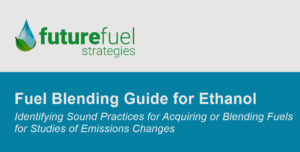 Future Fuel Strategies has published a new Fuel Blending Guide for Ethanol for researchers conducting fuel and emission testing.
Future Fuel Strategies has published a new Fuel Blending Guide for Ethanol for researchers conducting fuel and emission testing.
“This guide presents a step by step approach to designing a comparative market fuel emission study. This should matter greatly to the affected industries, auto, oil, ethanol- because it is these studies that are being used to design fuel/emissions regulations that directly impact the industry,” said Future Fuel Strategies Principal Consultant Tammy Klein.
The guide on Identifying Sound Practices for Acquiring or Blending Fuels for Studies of Emissions Changes was commissioned by the Urban Air Initiative (UAI) due to the fact that the way test fuels are blended dictate emission results.
Urban Air’s Technical Director Steve Vander Griend found that if there was a standardized way test fuels were blended, a lot of studies would have very different outcomes. “Having a uniform approach to blending test fuels will mean we will get accurate results. This fuel blending guide encourages using test fuels that represent real-world fuels. By doing this, emissions testing will show that ethanol reduces toxic aromatics in gasoline, reducing tailpipe emissions and improving air quality,” said Vander Griend.
The Fuel Blending Guide is intended for researchers to use as an educational tool and for third party organizations like the Society of Automotive Engineers to consider when conducting peer review on fuel studies. It also provides the opportunity to look back at past studies and identify flaws within the fuel testing to ensure more accurate results in the future.

